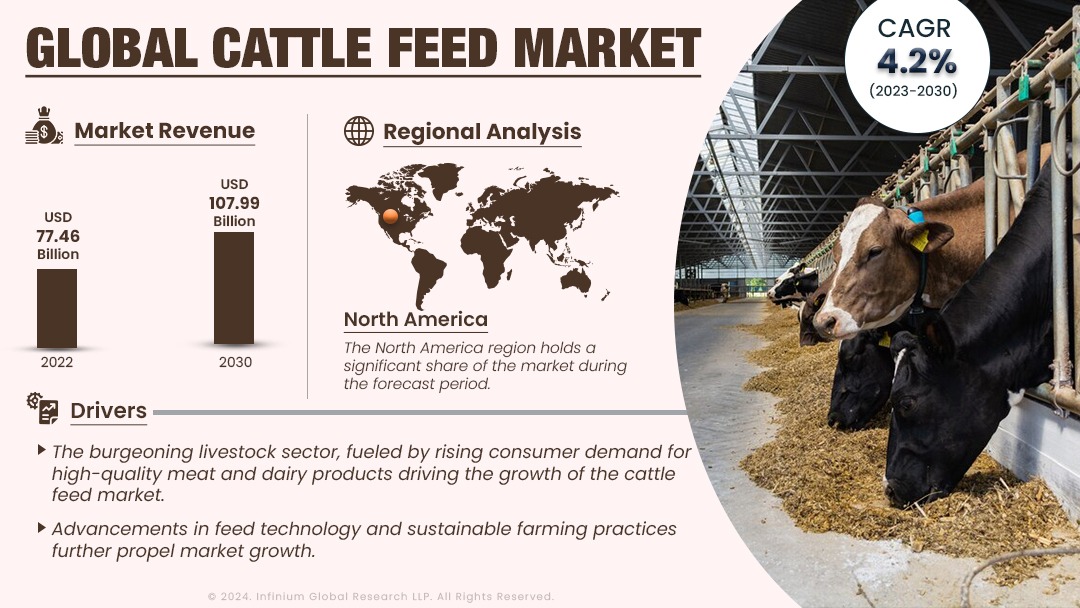Cattle Feed Market (Ingredient - Corn, Soybean Meal, Wheat, Oilseeds, Additives, and Others; Application - Agriculture, and Industrial; Cattle Type - Beef, and Dairy; Source - Organic, and Conventional; Distribution Channel - Online, and Offline): Global Industry Analysis, Trends, Size, Share and Forecasts to 2030
A recent report published by Infinium Global Research on cattle feed market provides in-depth analysis of segments and sub-segments in the global as well as regional cattle feed market. The study also highlights the impact of drivers, restraints, and macro indicators on the global and regional cattle feed market over the short term as well as long term. The report is a comprehensive presentation of trends, forecast and dollar values of global cattle feed market.
Market Insight:
Cattle feed plays a crucial role in the livestock industry, ensuring the health and productivity of cattle. Typically composed of grains, forages, minerals, and supplements, it provides essential nutrients such as protein, carbohydrates, vitamins, and minerals required for growth, reproduction, and overall well-being. The formulation of cattle feed is a science that considers the nutritional needs of different age groups and production stages of cattle. Balanced diets promote optimal weight gain, milk production, and reproductive efficiency. Modern cattle feed may include ingredients like soybean meal, corn, alfalfa, and specialized supplements. The industry continually evolves, incorporating scientific advancements to enhance nutritional content and promote sustainable farming practices. Efficient cattle feed management not only supports the health of the animals but also contributes to the production of quality meat and dairy products for human consumption.
The burgeoning livestock sector is fueled by rising consumer demand for high-quality meat and dairy products. As discerning consumers seek high-quality, ethically sourced options, the industry experiences unprecedented growth. This surge is fueled by a confluence of factors, including changing dietary preferences, a global rise in disposable income, and a growing awareness of the nutritional benefits associated with top-tier livestock products. Producers are adapting to meet this demand, employing advanced farming techniques and sustainable practices to ensure the continued delivery of superior and ethically produced meat and dairy options, thus driving the sector's expansion. Additionally, advancements in feed technology and sustainable farming practices further propel market growth. The convergence of these factors creates a favorable environment for the expansion of the cattle feed market, addressing the evolving needs of the thriving livestock industry. However, fluctuating raw material prices pose a challenge to the cattle feed market's stability. Furthermore, the growing focus on sustainable and innovative feed solutions presents a significant opportunity for market expansion. Adoption of eco-friendly practices, advanced technologies, and nutritional advancements not only enhances livestock productivity but also aligns with the rising consumer preference for ethically sourced and environmentally responsible agricultural products.

The North America region holds a significant share of the market during the forecast period. The demand for cow feed is rising as the population grows. Due to the high demand and escalating market competitiveness, the value of cattle and calf production in the U.S. is rising. The high demand for cattle feed to increase the efficiency of the animals is driving the growth of the region. Further, the Asia Pacific region is anticipated to grow at the fastest rate over the projection period. Because of their large populations and sharply rising milk and milk product consumption emerging economies like China and India have seen a tremendous increase in their cattle inventories during the past ten years. Along with this, the surge in demand for dairy products in Asian countries is notably driven by an increased preference among vegan consumers. This heightened traction is influenced by key macroeconomic factors, including the rise in social media usage and an upswing in per-capita income. These factors collectively contribute significantly to the overall expansion of the cattle feed market in the region.
Report Scope of the Cattle Feed Market:
| Report Coverage | Details |
|---|---|
| Market Size in 2022 | USD 77.46 Billion |
| Market Size by 2030 | USD 107.99 Billion |
| Growth Rate from 2023 to 2030 | CAGR of 4.2% |
| Largest Market | North America |
| No. of Pages | 350 |
| Market Drivers |
|
| Market Segmentation | By Ingredient, By Application, By Cattle Type, By Source, and By Distribution Channel |
| Regional Scope | North America, Europe, Asia Pacific, and RoW |
Segment Covered
The report on global cattle feed market covers segments such as ingredient, application, cattle type, source, and distribution channel. On the basis of ingredient, the sub-markets include corn, soybean meal, wheat, oilseeds, additives, and others. On the basis of application, the sub-markets include agriculture, and industrial. On the basis of cattle type, the sub-markets include beef, and dairy. On the basis of source, the sub-markets include organic, and conventional. On the basis of distribution channel, the sub-markets include online, and offline.
Companies Profiled:
The report provides profiles of the companies in the market such as Cargill, Incorporated, Purina Animal Nutrition LLC., ARASCO, Alberta Investment Management Corporation (AIMCo), AL-KHAIRAT Co., Godrej Agrovet Limited, Bharat Feeds & Extractions Ltd, De Heus Animal Nutrition, Arivan Agrovet Products, and Farmers Grain Company.
Report Highlights:
The report provides deep insights into demand forecasts, market trends, and micro and macro indicators. In addition, this report provides insights into the factors that are driving and restraining the growth in this market. Moreover, The IGR-Growth Matrix analysis given in the report brings an insight into the investment areas that existing or new market players can consider. The report provides insights into the market using analytical tools such as Porter's five forces analysis and DRO analysis of the cattle feed market. Moreover, the study highlights current market trends and provides forecasts from 2023-2030. We also have highlighted future trends in the market that will affect the demand during the forecast period. Moreover, the competitive analysis given in each regional market brings an insight into the market share of the leading players.
Please Choose One of them.